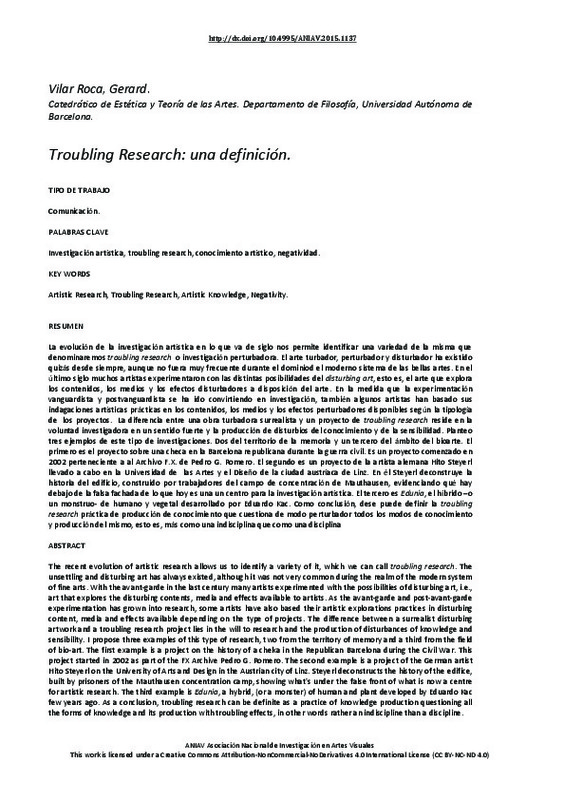JavaScript is disabled for your browser. Some features of this site may not work without it.
Buscar en RiuNet
Listar
Mi cuenta
Estadísticas
Ayuda RiuNet
Admin. UPV
Troubling Research: una definición
Mostrar el registro sencillo del ítem
Ficheros en el ítem
| dc.contributor.author | Vilar Roca, Gerard
|
es_ES |
| dc.date.accessioned | 2017-10-03T10:01:25Z | |
| dc.date.available | 2017-10-03T10:01:25Z | |
| dc.date.issued | 2015-11-26 | |
| dc.identifier.isbn | 9788490483411 | |
| dc.identifier.uri | http://hdl.handle.net/10251/88532 | |
| dc.description.abstract | [EN] The recent evolution of artistic research allows us to identify a variety of it, which we can call troubling research. The unsettling and disturbing art has always existed, although it was not very common during the realm of the modern system of fine arts. With the avant--‐garde in the last century many artists experimented with the possibilities of disturbing art, i.e., art that explores the disturbing contents, media and effects available to artists. As the avant--‐garde and post--‐avant--‐garde experimentation has grown into research, some artists have also based their artistic explorations practices in disturbing content, media and effects available depending on the type of projects. The difference between a surrealist disturbing artwork and a troubling research project lies in the will to research and the production of disturbances of knowledge and sensibility. I propose three examples of this type of research, two from the territory of memory and a third from the field of bio--‐art. The first example is a project on the history of a cheka in the Republican Barcelona during the Civil War. This project started in 2002 as part of the FX Archive Pedro G. Romero. The second example is a project of the German artist Hito Steyerl on the University of Arts and Design in the Austrian city of Linz. Steyerl deconstructs the history of the edifice, built by prisoners of the Mauthausen concentration camp, showing what's under the false front of what is now a centre for artistic research. The third example is Edunia, a hybrid, (or a monster) of human and plant developed by Eduardo Kac few years ago. As a conclusion, troubling research can be definite as a practice of knowledge production questioning all the forms of knowledge and its production with troubling effects, in other words rather an indiscipline than a discipline. | es_ES |
| dc.description.abstract | [ES] La evolución de la investigación artística en lo que va de siglo nos permite identificar una variedad de la misma que denominaremos troubling research o investigación perturbadora. El arte turbador, perturbador y disturbador ha existido quizás desde siempre, aunque no fuera muy frecuente desde que se consolidó el moderno sistema de las bellas artes hasta su desaparición con las vanguardias del siglo XX. En el último siglo muchos artistas experimentaron con las distintas posibilidades del disturbing art, esto es, el arte que explora los contenidos, los medios y los efectos disturbadores a disposición del arte. Dadaístas, surrealistas o accionistas fueron grandes experimentadores en este terreno. En la medida que la experimentación vanguardista y postvanguardista se ha ido convirtiendo en investigación, también algunos artistas han basado sus indagaciones artísticas prácticas en los contenidos, los medios y los efectos perturbadores disponibles según la tipología de los proyectos. La diferencia entre una obra turbadora surrealista y un proyecto de troubling research reside en la voluntad investigadora en un sentido fuerte y la producción de cierto tipo de conocimiento. Pondré tres ejemplos de este tipo de investigaciones. Dos del territorio de la memoria y un tercero del ámbito del bioarte. El primero es el proyecto sobre una checa en la Barcelona republicana durante la guerra civil. Es un proyecto comenzado en 2002 perteneciente a al Archivo F.X. de Pedro G. Romero. El segundo es un proyecto de la artista alemana Hito Steyerl llevado a cabo en la Universidad de las Artes y el Diseño de la ciudad austríaca de Linz. En él Steyerl deconstruye la historia del edificio, construido por trabajadores del campo de concentración de Mauthausen, evidenciando qué hay debajo de la falsa fachada de lo que hoy es una facultad de arte. El tercero es el híbrido –o un monstruo- de humano y vegetal desarrollado por Eduardo Kac. | es_ES |
| dc.format.extent | 5 | es_ES |
| dc.language | Español | es_ES |
| dc.publisher | Editorial Universitat Politècnica de València | es_ES |
| dc.relation.ispartof | II CONGRESO INTERNACIONAL DE INVESTIGACIÓN EN ARTE VISUALES | es_ES |
| dc.rights | Reconocimiento - No comercial - Sin obra derivada (by-nc-nd) | es_ES |
| dc.subject | Arte | es_ES |
| dc.subject | Producción artística | es_ES |
| dc.subject | Estética | es_ES |
| dc.subject | Teoría del Arte | es_ES |
| dc.subject | Gestión cultural | es_ES |
| dc.subject | Educación artística | es_ES |
| dc.subject | Investigación artística | es_ES |
| dc.title | Troubling Research: una definición | es_ES |
| dc.type | Capítulo de libro | es_ES |
| dc.type | Comunicación en congreso | es_ES |
| dc.identifier.doi | 10.4995/ANIAV2015.1137 | |
| dc.rights.accessRights | Abierto | es_ES |
| dc.description.bibliographicCitation | Vilar Roca, G. (2015). Troubling Research: una definición. En II CONGRESO INTERNACIONAL DE INVESTIGACIÓN EN ARTE VISUALES. Editorial Universitat Politècnica de València. 700-704. https://doi.org/10.4995/ANIAV2015.1137 | es_ES |
| dc.description.accrualMethod | OCS | es_ES |
| dc.relation.conferencename | II Congreso Internacional de Investigación en Artes Visuales. |< real | virtual >| ANIAV2015 | es_ES |
| dc.relation.conferencedate | July 09-10,2015 | es_ES |
| dc.relation.conferenceplace | Valencia, Spain | es_ES |
| dc.relation.publisherversion | http://ocs.editorial.upv.es/index.php/ANIAV/ANIAV2015/paper/view/1137 | es_ES |
| dc.description.upvformatpinicio | 700 | es_ES |
| dc.description.upvformatpfin | 704 | es_ES |
| dc.type.version | info:eu-repo/semantics/publishedVersion | es_ES |
| dc.relation.pasarela | OCS\1137 | es_ES |








